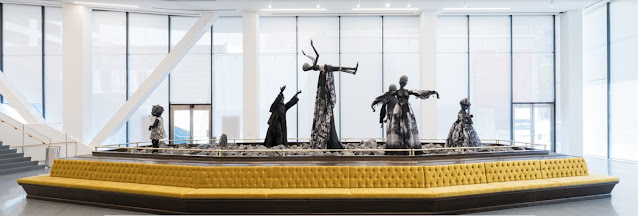For LGBT History Month, I would like to highlight an aspect of WWII that is not talked about much...not only the persecution, imprisonment, torture, and slaughter of gay men at the hands of the Nazis,
but the continued persecution and imprisonment of gay men after the war at the hands of ordinary German citizens due to a monstrous law called Paragraph 175.
At the end of WWII, tens of thousands of people were liberated from Nazi concentration camps. But what is deliberately overlooked is the fact that gay male prisoners wearing the pink triangle (the Nazis’ symbol to brand homosexuals) were forced to serve out the rest of their sentence as it was laid out in this draconian law.
In an
article for the news outlet Los Angeles Blade, journalist Karen Ocamb succinctly wrote:
"According to the United States Holocaust Memorial Museum, the total number of those murdered by Nazis and their collaborators during the Holocaust was 17 million men, women and children: 6 million were Jews and 11 million were other ethnicities, including Soviets, Slavs, Poles and Ukrainians, Romanis/Gypsies (classified as enemies of the state, like Jews), the disabled – and homosexuals.
No one really knows or seems to care how many LGBTQ people were killed, tortured, maimed or castrated, except, thankfully, the US Holocaust Museum. 'More than one million gay Germans were targeted, of whom at least 100,000 were arrested and 50,000 were convicted and imprisoned,' reports the Museum via Wikipedia. An estimated 5,000 to 15,000 gay men were imprisoned in concentration camps and died at high rates, according to a survivor. They were forced to wear identifiable pink triangles, as were those convicted of pedophilia and bestiality.
But unlike other survivors liberated from concentration camps as World War II ended, gays were persecuted and re-imprisoned under Germany’s anti-gay law, Paragraph 175."
Paragraph 175 is extensively detailed on a
dedicated Wikipedia page, which states that:
"Paragraph 175 (known formally as §175 StGB; also known as Section 175 in English) was a provision of the German Criminal Code from 15 May 1871 to 10 March 1994. It made sexual relations between males a crime, and in early revisions the provision also criminalized bestiality as well as forms of prostitution and underage sexual abuse. While the Nazi persecution of homosexuals is reasonably well known today, far less attention has been given to the continuation of this persecution in post-war Germany.[4] In 1945, after the concentration camps were liberated, some homosexual prisoners were recalled to custody to serve out their two-year sentence under Paragraph 175.[7] In 1950, East Germany abolished Nazi amendments to Paragraph 175, whereas West Germany kept them and even had them confirmed by its Constitutional Court. About 100,000 men were implicated in legal proceedings from 1945 to 1969, and about 50,000 were convicted.[4] Some individuals accused under Paragraph 175 committed suicide. In 1969, the government eased Paragraph 175 by providing for an age of consent of 21.[8] The age of consent was lowered to 18 in 1973, and finally, in 1994, the paragraph was repealed and the age of consent lowered to 16, the same that is in force for heterosexual acts."
It remains heartbreaking that so many thousands and thousands of men were denied human treatment after a war that saw their humanity crushed to begin with. I recall going to the site of the Dachau concentration camp on a visit to Germany in 1988 where there were monuments to every persecuted and slaughtered religious or ethnic group, except gay men (lesbians were not included in Paragraph 175). In one of the interpretive libraries, I saw a pink granite triangle plaque on an easel with an accompanying petition to sign, urging the organization that oversees the Dachau site to place the small monument in memory of all those men. Even in 1988, we were still fighting to be recognized as having been in the camps
at all. The survivors of the camps, in particular Dachau, did not want to be seen as having anything in common with what they clearly viewed as prisoners lesser than themselves, prisoners who, one suspects, they believed deserved to be there, and to have died at the hands of Nazis. It was not until 1995 that the plaque was allowed to be placed.




















































